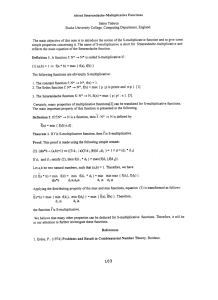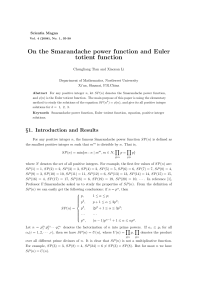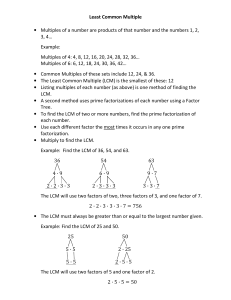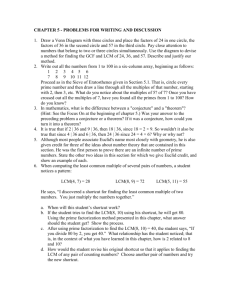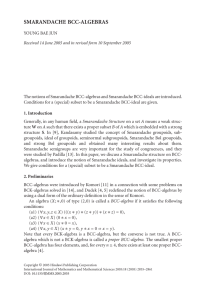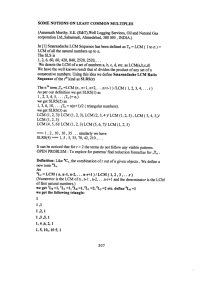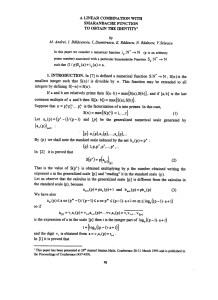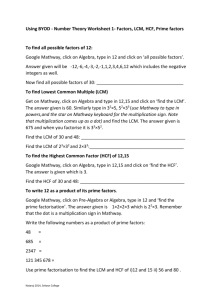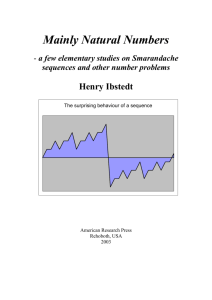On Smarandache least common multiple ratio
advertisement
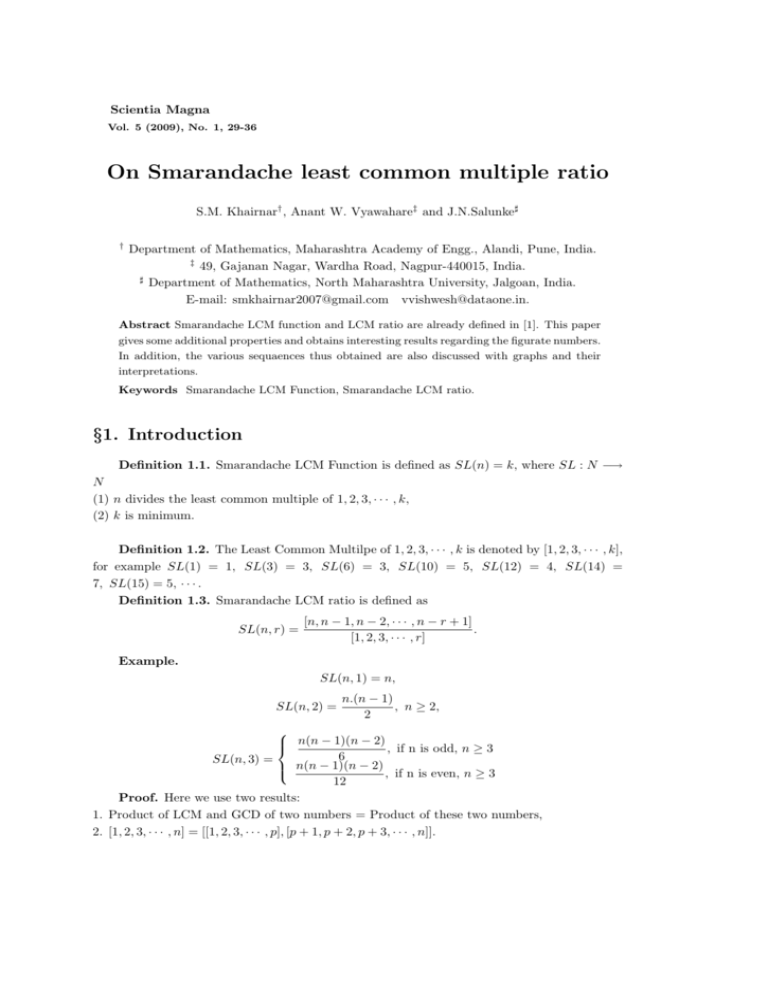
Scientia Magna
Vol. 5 (2009), No. 1, 29-36
On Smarandache least common multiple ratio
S.M. Khairnar† , Anant W. Vyawahare‡ and J.N.Salunke]
†
Department of Mathematics, Maharashtra Academy of Engg., Alandi, Pune, India.
‡
49, Gajanan Nagar, Wardha Road, Nagpur-440015, India.
]
Department of Mathematics, North Maharashtra University, Jalgoan, India.
E-mail: smkhairnar2007@gmail.com vvishwesh@dataone.in.
Abstract Smarandache LCM function and LCM ratio are already defined in [1]. This paper
gives some additional properties and obtains interesting results regarding the figurate numbers.
In addition, the various sequaences thus obtained are also discussed with graphs and their
interpretations.
Keywords Smarandache LCM Function, Smarandache LCM ratio.
§1. Introduction
Definition 1.1. Smarandache LCM Function is defined as SL(n) = k, where SL : N −→
N
(1) n divides the least common multiple of 1, 2, 3, · · · , k,
(2) k is minimum.
Definition 1.2. The Least Common Multilpe of 1, 2, 3, · · · , k is denoted by [1, 2, 3, · · · , k],
for example SL(1) = 1, SL(3) = 3, SL(6) = 3, SL(10) = 5, SL(12) = 4, SL(14) =
7, SL(15) = 5, · · · .
Definition 1.3. Smarandache LCM ratio is defined as
SL(n, r) =
[n, n − 1, n − 2, · · · , n − r + 1]
.
[1, 2, 3, · · · , r]
Example.
SL(n, 1) = n,
SL(n, 2) =
n.(n − 1)
, n ≥ 2,
2
n(n − 1)(n − 2) , if n is odd, n ≥ 3
6
SL(n, 3) =
n(n − 1)(n − 2) , if n is even, n ≥ 3
12
Proof. Here we use two results:
1. Product of LCM and GCD of two numbers = Product of these two numbers,
2. [1, 2, 3, · · · , n] = [[1, 2, 3, · · · , p], [p + 1, p + 2, p + 3, · · · , n]].
30
S.M. Khairnar, Anant W. Vyawahare and J.N.Salunke
No. 1
Now,
SL(n, 3) =
[n, n − 1, n − 2]
,
[1, 2, 3]
·
¸
(n − 1)(n − 2)
Here, [n, n − 1, n − 2] = n,
.
(n − 1, n − 2)
But (n − 1, n − 2) = GCD of n-1 and n-2, which is always 1.
Hence, [n, n − 1, n − 2] = [n, (n − 1)(n − 2)] and clearly [1, 2, 3] = 6.
At n = 3 : (1) ⇒ SL(3, 3) =
[3, 2, 1]
3×2×1
6
=
= = 1.
[1, 2, 3]
6
6
[6, 5, 4]
6×5×4
At n = 6 : (1) ⇒ SL(6, 3) =
=
= 10.
[1, 2, 3, 4]
12
n(n − 1)(n − 2) , if n is odd
6
Hence, SL(n, 3) =
n(n − 1)(n − 2) , if n is even
12
is proved.
[n, n − 1, n − 2, n − 3]
,
for n ≥ 4
[1, 2, 3, 4]
n.(n − 1).(n − 2).(n − 3)
Similarly SL(n, 4) =
,
if 3 does not divides n
24
n.(n
−
1).(n
−
2).(n
−
3)
,
if 3 divides n
72
n.(n − 1).(n − 2).(n − 3).(n − 4)
Similarly, SL(n, 5) =
, with other conditions also.
360
Here, we have used only the general valuesof LCM ratios given in ([2] and [3]).
The other results can be obtained similarly.
§2. Sets of SL(n, r) [2]
(1) SL(n, 1) = {1, 2, 3, 4, 5, 6, · · · , n, · · · } It is a set of natural numbers.
n(n − 1)
, · · · } It is a set of triangular numbers.
2
n(n − 1)(n − 2)
(3) SL(n, 3) = {1, 2, 10, 10, 35, 28, 84, · · · ,
, · · · }.
12
This set, with more elements, is {1, 2, 10, 10, 35, 28, 84, 60, 165, 110, 286, 182, 455,
280, 680, 408, 969, 570, 1330, 770, 1771, 1012, 2300, 1300, 2925, 1638, 3654, 2030, 4495, 2480,
5456, 2992, 6545, 3570, 7770, 4218, 9139, 4940, 10660, 5740, 12341, 6622, 14190, · · · }.
(2) SL(n, 2) = {1, 3, 6, 10, · · · ,
Its generating function is
x4 + 2x3 + 6x2 + 2x + 1
.
(1 − x2 )4
(1)
Vol. 5
On Smarandache least common multiple ratio
31
Graph of SL(n,3)
Physical Interpretation of Graph of SL(n,3): This graph, given on the next page, represents the
V-I characteristic of two diodes in forward bias mode. It is represented by the equation:
eV
I = I0 {exp( kBT
) − 1}, a rectifier equation, where,
I0 = total saturation current,
e = charge on electron,
V = applied voltage,
kB = Boltzman’s constant, and
T = temperature.
Here V is positive. X-axis represents voltage V and Y-axis is current in mA.
Also, this graph represents harmonic oscillator: Kinetic energy along Y -axis and velocity along
X-axis.
32
S.M. Khairnar, Anant W. Vyawahare and J.N.Salunke
No. 1
Graph of SL(n,4)
n(n − 1)(n − 2)(n − 3)
(4) SL(n, 4) = {1, 5, 5, 35, 70, 42, · · · ,
, . . .},
72
This set, to certain terms is {1, 5, 5, 35, 70, 42, 210, 330, 165, 715, 1001, 455,
1820, 2380, 1020, 3876, 4845, 1995, 7315, 8855, 3542, 12650, 14950, 5850, 20475, 23751, 9135,
31465, 35960, 13640, 46376, 52360, 19635, 66045, 73815, 27417, 91390, 101270, 37310, 123410, · · · }.
Physical Interpretation of Graph of SL(n,4): This graph, the image of graph about a line
of symmetry y = x, is a temperature-resistance characteristic of a thermister.
Its equation is R = R0 . exp[β( T1 − T10 )], where
R0 = resistance of room temperature,
R = resistance at different temperature,
β = constant,
T0 = room temperature.
Vol. 5
On Smarandache least common multiple ratio
33
Graph of SL(n,5)
Temperature T , in Kelvin units, along X-axis and resistance R, in ohms, along Y-axis, β
value lies between 3000 and 4000.
β
The above equation can be put as R = C.e T .
Its another representation is potential energy (in ergs, along Y-axis) of system of spring
against extension (in cetimeters along X-axis) for different weights.
The second graph below is characteristic curve of VCE against ICE at constant base current
IB .
n(n − 1)(n − 2)(n − 3)(n − 4)
(5) SL(n, 5) = {1, 1, 1, 7, 14, 42, 42, · · · ,
, · · · } This set, to
360
certain terms, is {1, 1, 7, 14, 42, 42, 462, 66, 429, 1001, 1001, 364, 6188, 1428 · · · }
Physical Interpretation of Graph of SL(n,5): The second graph of {SL(n, 5)}, given above,
represents the V-I characteristic of two diodes in reverse bias mode. It is represented by the
same equation mentioned in graph of SL(n, 3) with a change that V is negative.
Hence, −V ≥
4kBT
e
−eV
, and that exp( kBT
) ≤ 1, so that I = I0 .
This shows that the current is in reverse bias and remains constant at I0 , the saturation
current, until the junction breaks down. Axes parameters are as above.
Similarly for the other sequences.
34
S.M. Khairnar, Anant W. Vyawahare and J.N.Salunke
No. 1
§3. Properties [3]
Murthy [1] formed an interserting triangle of the above sequences by writing them vertically, as follows:
1
1
1
1
2
1
1
3
3
1
1
4
6
2
1
1
5
10
10
5
1
1
6
15
10
5
1
1
1
7
21
35
35
7
7
1
1
8
28
28
70
14
14
2
1
1
9
36
84
42
42
42
6
3
1
1
10
45
60
210
42
42
6
3
1
1
1. Here, the first column and the leading diogonal contains all unity.
The second column contains the elements of sequence SL(n, 1).
The third column contains the elements of sequence SL(n, 2).
The fourth column contains the elements of sequence SL(n, 3).
and similarly for other columns.
2. Consider that row which contains the elements 1 1 only as first row.
If p is prime, the sum of all elements of pth row ≡ 2(mod p).
If p is not prime, the sum of all elements of 4th row ≡ 2(mod 4).
The sum of all elements of 6th row ≡ 3(mod 6).
The sum of all elements of 8th row ≡ 6(mod 8).
The sum of all elements of 9th row ≡ 5(mod 5).
The sum of all elements of 10th row ≡ 1(mod 10).
§4. Difference
We have,
SL(n, 2) − SL(n − 1, 2) = SL(n − 1, 1).
This needs no verification.
Also, SL(n, 3) − SL(n − 1, 3) =
n(n − 1)(n − 2) (n − 1)(n − 2)(n − 3)
−
6
6
(n − 1)(n − 2)
=
= SL(n − 1, 2).
2
Vol. 5
On Smarandache least common multiple ratio
Similarly,
SL(n, 4) − SL(n − 1, 3) = SL(n − 1, 3)
SL(n, 5) − SL(n − 1, 5) = SL(n − 1, 4).
Hence, in general,
SL(n, r) − SL(n − 1, r) = SL(n − 1, r − 1), r < n.
§5. Summation
Adding the above results, we get,
∞
X
SL(n, r) = n − 1, n > 1.
r=2
§6. Ratio
We have,
n−2
SL(n, 3)
=
,
SL(n, 2)
3
SL(n, 4)
n − 3 SL(n, 5)
n−4
=
,
=
.
SL(n, 3)
4
SL(n, 4)
5
In general,
n−r
SL(n, r + 1)
=
.
SL(n, r)
r+1
§7. Sum of reciprocals of two cosecutive LCM ratios
We have,
1
1
n+1
+
=
,
SL(n, 2) SL(n, 3)
3 · SL(n, 3)
1
1
n+1
1
1
n+1
+
=
,
+
=
.
SL(n, 3) SL(n, 4)
4 · SL(n, 4) SL(n, 4) SL(n, 5)
5 · SL(n, 5)
In general,
1
n+1
1
+
=
.
SL(n, r) SL(n, r + 1)
(r + 1) · SL(n, r + 1)
35
36
S.M. Khairnar, Anant W. Vyawahare and J.N.Salunke
No. 1
§8. Product of two cosecutive LCM ratios
1. SL(n, 1) · SL(n, 2) =
n2 (n − 1)
2!
2. SL(n, 2) · SL(n, 3) =
n2 (n − 1)2 (n − 2)
2! · 3!
3. SL(n, 3) · SL(n, 4) =
n2 (n − 1)2 (n − 2)2 (n − 3)
3! · 4!
4. SL(n, 4) · SL(n, 5) =
n2 (n − 1)2 (n − 2)2 (n − 3)2 (n − 4)
4! · 5!
In general,
SL(n, r) · SL(n, r + 1) =
n2 · (n − 1)2 · (n − 2)2 · (n − 3)2 · · · · · (n − r + 1)2 · (n − r)
.
r! · (r + 1)!
References
[1] Amarnath Murthy, Some notions on Least common multiples, Smarandache Notions
Journal, 12(2001), 307-308.
[2] Maohua Le, Two Formulas of Smarandache LCM Ratio Sequences, Smarandache Notions Journal, 14(2004), 183-185.
[3] Wang Ting, Two Formulas of Smarandache LCM Ratio Sequences, Scientia Magna,
1(2005), No.1, 109-113.
